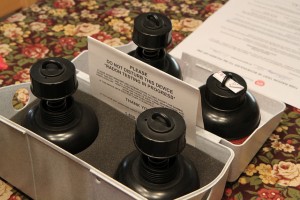We’ve established by now, that radon is a naturally occurring gas that seeps into homes through cracks in the foundation, walls and flooring. However, as evidenced by the existence of radon gas in water supply there are other ways you can come into contact with the deadly gas. Although they might seem dangerous or scary, the only real danger is when it collects in great abundance in your home.
Still, it helps to know when and where you may encounter a radon gas source in the world around you.
Radon Gas Source: The Open Air
Believe it or not, a certain amount of radon gas exists in the open air. Yes, the air you breathe is a radon gas source.
The national average of outdoor radon levels is 0.4 pCi/L, but in some cases it can be as high as 0.75 pCi/L. The National Academy of Sciences estimates that outdoor radon levels are responsible for approximately 800 of the 21,000 radon induced lung cancer deaths in the country each year. While not quite as significant as the total number of those affected by radon, it is enough to make a difference.
That explains why it is so important to limit exposure to elevated levels of radon gas. Seeing as many of us are already exposed to the silent killer in some form or another, it’s never good to increase total exposure, especially in concentrated amounts. You’re never truly far from a radon gas source.
Radon Gas Source: Rocks and Building Materials
 You may have heard claims that radon gas can enter your home after being released by a granite countertop or similar building materials. This is true, however the likelihood of this source being hazardous to ones health is low. Radon does seep out of various rocks and natural materials in extremely small amounts. This alone, is not enough to cause a significant buildup in your home or residence. Of course, if you already have elevated levels in your home this can certainly make things worse.
You may have heard claims that radon gas can enter your home after being released by a granite countertop or similar building materials. This is true, however the likelihood of this source being hazardous to ones health is low. Radon does seep out of various rocks and natural materials in extremely small amounts. This alone, is not enough to cause a significant buildup in your home or residence. Of course, if you already have elevated levels in your home this can certainly make things worse.
If you’re truly concerned about granite countertop or similar materials you can purchase testing kits that will tell you how much radon they’re giving off.
Radon Gas Source: The Water Supply
A certain amount of radon gas can enter the home — and your body — through a water supply. More often than not, like with granite countertops, it’s not a high enough concentration to cause a problem. However, there have been cases where high amounts of radon gas have been found in a water supply. Generally, this is when a well is involved — as the gas can be trapped inside. You may or may not find traces of radon gas in a treated city-based water supply.
While it is debated, health risks associated with radon ingestion — through a water supply — seem to be almost negligable. You’re most at risk when the radon daughters and particles are absorbed by the lungs.
Radon Gas Source: Your Home
Not all homes have elevated levels of radon, but enough do that it should concern every homeowner. It is estimated that every one in fifteen homes in the country have elevated levels within.
Radon gas seeps in through cracks in the foundation, walls and flooring. It’s a natural decay product of elements such as Uranium, commonly found in the soil and rock underneath our feet — and our homes.
Once it seeps inside a home, it collects in concentrated amounts and does not dissipate as its a remarkably dense gas. Opening doors and windows won’t help anything either. In fact, in many cases it may even make the problem worse.
The only way to remove radon from a home is to install a mitigation system. The problem, however is detecting the gas. It’s invisible and virtually undetectable: odorless, colorless and tasteless. The only way to discover whether or not its a problem is to test specifically for it. Luckily, you can purchase a DIY testing kit at any local hardware store or online for relatively cheap ($10 – $20). Sadly, most people don’t even have a clue it’s a danger, let alone that it could be lurking in their home.
Radon gas is the leading cause of lung cancer in many countries — not just the US. Here in the states, it’s responsible for the deaths of more than 21,000 each year. As you can see, it’s a pretty serious issue any way you cut it.




